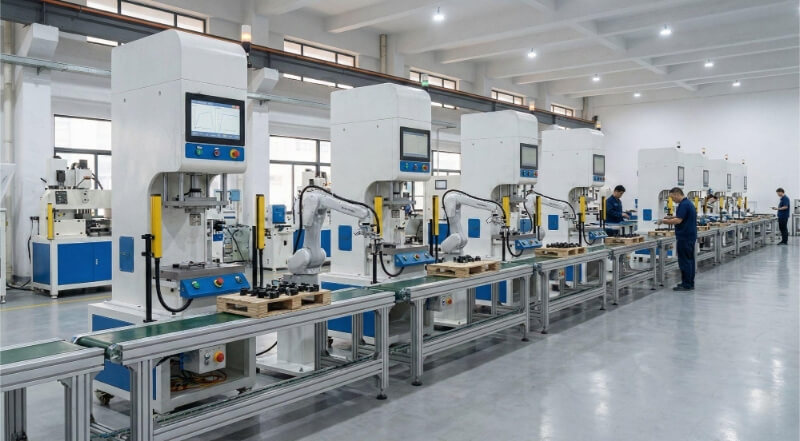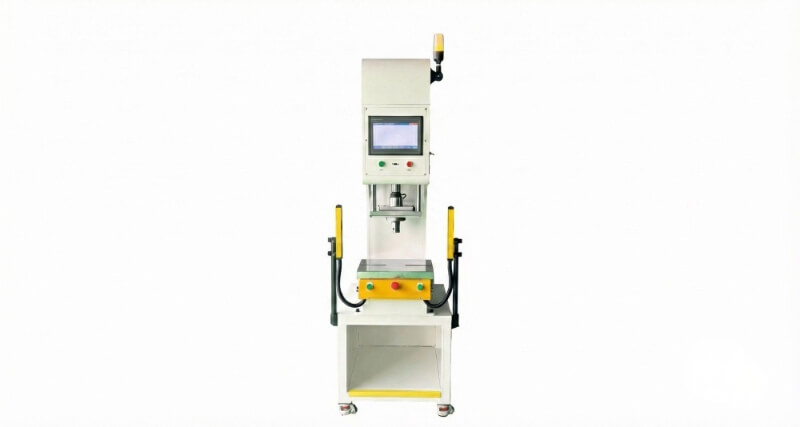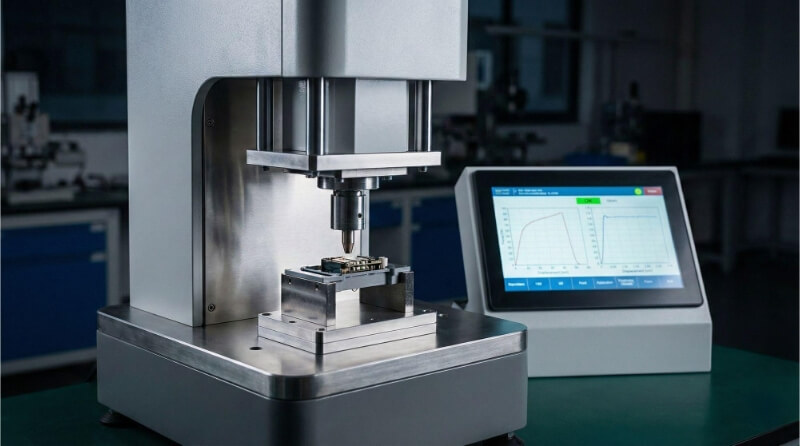تواجه كل شركة مصنعة ثلاثة تحديات حاسمة: تحقيق قطع دقيق، والحفاظ على جودة متسقة، والوفاء بمواعيد الإنتاج الضيقة. وغالبًا ما يحتاج القطع اليدوي للمعادن إلى اللحاق بالركب، مما يؤدي إلى إهدار المواد والأخطاء المكلفة والتأخير في المشروع. لقد أحدث القطع المعدني باستخدام الحاسب الآلي ثورة في التصنيع من خلال حل هذه المشاكل بالتحديد.
هل ترغب في استكشاف كيف يمكن لهذه التقنية المتطورة أن تعزز قدراتك التصنيعية؟ دعنا نفحص العمليات والتطبيقات والمزايا الرئيسية التي تجعل من القطع المعدني باستخدام الحاسب الآلي جزءًا لا غنى عنه في الإنتاج الحديث.
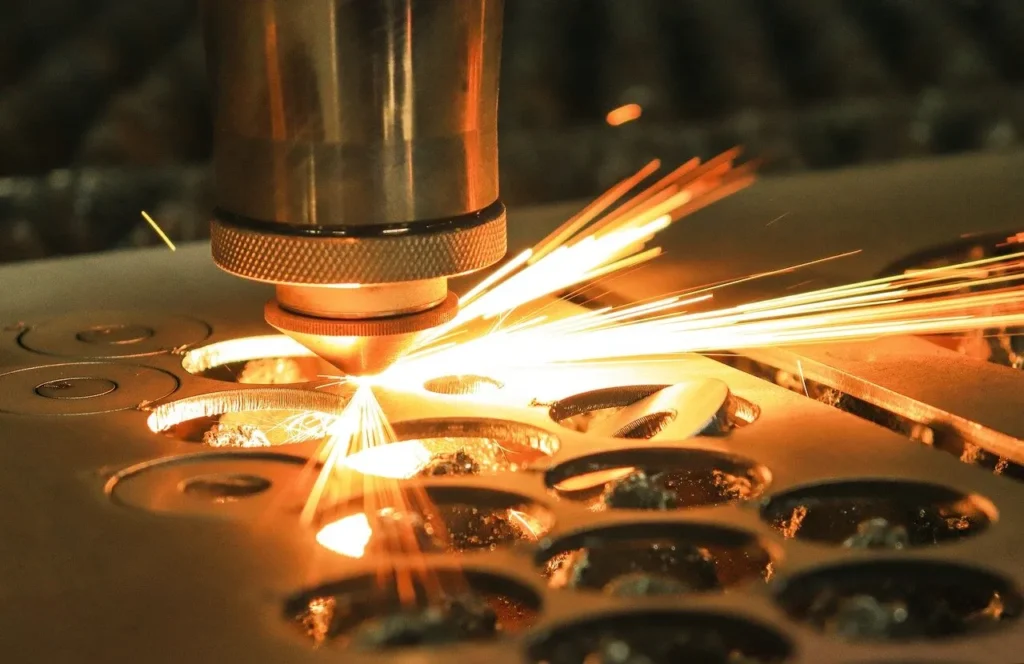
أساسيات قطع المعادن باستخدام الحاسب الآلي
أحدث التحكم العددي بالكمبيوتر ثورة في تشغيل المعادن من خلال إدخال الدقة الآلية في التصنيع. تعمل هذه التقنية على سد الفجوة بين التصميم والإنتاج، وتحويل المخططات الرقمية إلى مكونات مادية.
ما هو قطع المعادن بنظام التحكم الرقمي باستخدام الحاسوب؟
يحوِّل القطع المعدني باستخدام الحاسب الآلي مخزون المعدن الخام إلى أجزاء تامة الصنع من خلال إزالة المواد التي يتم التحكم فيها. وتعتمد هذه العملية على أدوات قطع متخصصة تتبع مسارات دقيقة موجهة بالكمبيوتر. تُنتج هذه الطريقة كل شيء بدءًا من الأقواس البسيطة وحتى المكونات الفضائية المعقدة.
تبدأ العملية النموذجية لقطع المعادن باستخدام الحاسب الآلي بتصميم CAD. يقوم النظام بتحويل هذا التصميم إلى تعليمات ماكينة، والتي تقوم بعد ذلك بتوجيه أدوات القطع لإزالة المواد بشكل منهجي. ينتج عن ذلك قطع ذات دقة استثنائية، وغالبًا ما تتطلب الحد الأدنى من المعالجة اللاحقة.
كيفية عمل ماكينات CNC
فكّر في ماكينات التحكم الرقمي باستخدام الحاسب الآلي كأنظمة عالية التنسيق تعمل في تناغم تام. يقوم دماغ الكمبيوتر بتفسير التعليمات المبرمجة. ثم يقوم بتوجيه المكونات الميكانيكية بدقة متناهية في الثانية.
تراقب الماكينة متغيرات لا حصر لها أثناء التشغيل. تتغير سرعة القطع وموضع الأداة ومعدل تغذية المواد تلقائيًا حسب الحاجة. تمنع المستشعرات المتقدمة الأعطال وتحافظ على ظروف القطع المثلى.
أنواع ماكينات التحكم الرقمي باستخدام الحاسب الآلي المستخدمة في قطع المعادن
يخدم كل نوع من ماكينات بنظام التحكم الرقمي احتياجات تصنيع محددة. تتفوق ماكينات التفريز في إنشاء أشكال وأنماط ثلاثية الأبعاد معقدة. تنتج المخارط القِطع الأسطوانية بدقة مذهلة. تجمع الماكينات متعددة المحاور بين هذه الإمكانيات لتحقيق أقصى قدر من التنوع.
غالبًا ما يستخدم التصنيع الحديث ماكينات CNC متخصصة. حيث تقوم ماكينات التفريز خماسية المحاور بتصنيع مكونات فضائية معقدة. وتنتج المخارط من النوع السويسري أجهزة طبية صغيرة جداً. وتعالج الماكينات العملاقة الكبيرة الأجزاء الصناعية الضخمة. يضمن هذا التنوع قدرة المصنعين على اختيار الأداة المناسبة لكل مهمة.
عمليات قطع المعادن الرئيسية باستخدام الحاسب الآلي بنظام التحكم الرقمي
تخدم كل طريقة من طرق القطع باستخدام الحاسب الآلي احتياجات تصنيع محددة. تختلف هذه العمليات من حيث السرعة والدقة وتوافق المواد. يعتمد الاختيار على متطلبات مشروعك ونوع المواد وحجم الإنتاج.
الطحن: التعريف ونظرة عامة على العملية
طحن تستخدم أدوات دوارة لإزالة المعدن من قطع العمل. تتحرك أداة القطع عبر سطح المادة في اتجاهات متعددة، مما يؤدي إلى إنشاء أسطح مسطحة وأشكال ثلاثية الأبعاد معقدة وميزات تفصيلية.
الخراطة: كيف تعمل في قطع المعادن
تحول تقوم بتدوير قطعة العمل بينما تقوم أداة القطع الثابتة بتشكيلها. تتفوق هذه العملية في إنشاء أجزاء أسطوانية بدقة عالية. تشمل التطبيقات النموذجية الأعمدة والمسامير والمكونات المستديرة الأخرى.
الحفر: دور الحفر في القطع باستخدام الحاسب الآلي (CNC)
الحفر باستخدام الحاسب الآلي إنشاء ثقوب دقيقة في قطع العمل المعدنية. يضمن التحكم بالكمبيوتر اتساق قطر الثقب وعمقه. يمكن للماكينات الحديثة الحفر في زوايا وإنشاء أنماط ثقوب معقدة تلقائيًا.
تصنيع التفريغ الكهربائي (EDM)
تقوم EDM بقطع المعدن باستخدام شرارات كهربائية في سائل عازل. تتعامل هذه العملية مع الفولاذ المقوى والقطع الداخلي المعقد. وهي تحقق تفاوتات ضيقة للغاية بدون قوة ميكانيكية.
القطع بالليزر: نظرة عامة
القطع بالليزر يذيب أو يبخر المعدن بأشعة ضوئية مركزة. توفر هذه الطريقة حوافاً نظيفة وتفاصيل معقدة. وهي تعمل بشكل جيد للغاية مع الصفائح المعدنية والمواد الرقيقة.
القطع بالنفث المائي: المزايا والتطبيقات
نفاثات الماء مزج الماء بجزيئات كاشطة لقطع المعدن. تمنع عملية القطع على البارد هذه تشويه الحرارة. وهي تقطع المواد السميكة مع الحفاظ على خصائص المواد.
القطع بالبلازما: طريقة شائعة لتصنيع المعادن
قطع البلازما يستخدم غازًا مؤينًا لقطع المعادن الموصلة. توفر العملية سرعات قطع سريعة للمواد السميكة. وهي توازن بين التكلفة والجودة للعديد من التطبيقات الصناعية.
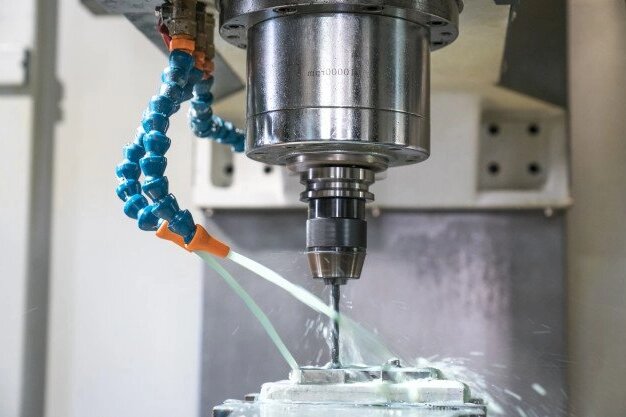
ما هي المواد التي يمكن قصها باستخدام ماكينات CNC؟
تختلف قدرات قطع المعادن حسب نوع المادة وسُمكها. تتوافق كل طريقة من طرق CNC مع خصائص معدنية محددة ومتطلبات العمل. توازن طريقة القطع المناسبة بين الدقة والسرعة وفعالية التكلفة.
إليك جدول مرجعي سريع للمواد القياسية وقدرات القطع الخاصة بها:
| نوع المادة | القطع بالليزر | التثقيب باستخدام الحاسب الآلي الرقمي | الطحن باستخدام الحاسب الآلي | قطع البلازما |
|---|---|---|---|---|
| الألومنيوم | حتى 10 مم | حتى 6 مم | لا يوجد حد للسُمك* | حتى 50 مم (بداية الحافة) |
| الفولاذ الطري | حتى 32 مم (1.25 بوصة) | 0.5-6 مم | لا يوجد حد للسُمك* | حتى 38 مم |
| الفولاذ المقاوم للصدأ | حتى 12 مم | 0.5-6 مم | لا يوجد حد للسُمك* | حتى 25 مم |
| نحاس | حتى 6 مم | حتى 4 مم | لا يوجد حد للسُمك* | حتى 20 مم |
| نحاس | حتى 4 مم | حتى 3 مم | لا يوجد حد للسُمك* | حتى 20 مم |
فوائد قطع المعادن باستخدام الحاسب الآلي بنظام التحكم الرقمي
يتطلب تصنيع المعادن الدقة والكفاءة في سوق اليوم التنافسي. تلبي تقنية التحكم الرقمي باستخدام الحاسوب هذه المتطلبات من خلال الجمع بين الأتمتة المتقدمة وقدرات التصنيع القوية. يستكشف هذا القسم المزايا الأساسية التي تجعل من قطع المعادن بنظام التحكم الرقمي حجر الزاوية في الإنتاج الحديث.
تعزيز الدقة والاتساق
يضمن التحكم الرقمي مطابقة كل عملية قطع للمواصفات بشكل مثالي. تحافظ الماكينات على الدقة في حدود ميكرون خلال عمليات الإنتاج. تؤدي هذه الدقة إلى ما يلي:
- نتائج قابلة للتكرار عبر آلاف القطع
- الحد الأدنى من التباين بين الدفعات
- تقليل مشكلات مراقبة الجودة
- تناسب وتجميع مثالي في المنتجات النهائية
كفاءة التكلفة والحد من النفايات
تعمل البرمجة والأتمتة المبتكرة على خفض تكاليف التشغيل بشكل كبير. تقلل دقة ماكينات التحكم الرقمي باستخدام الحاسب الآلي من هدر المواد. تظهر النتائج:
- انخفاض تكاليف العمالة لكل جزء
- انخفاض معدلات الخردة المادية
- عدد أقل من الأجزاء المرفوضة
- الاستخدام الأمثل للمواد
- انخفاض متطلبات إعادة العمل
إنتاج عالي السرعة وأزمنة دوران عالية
تعمل ماكينات التحكم الرقمي بنظام التحكم الرقمي بشكل أسرع من الطرق اليدوية مع الحفاظ على الجودة. تعمل بشكل مستمر بأقل وقت تعطل. تشمل المزايا ما يلي:
- القدرة على الإنتاج على مدار 24/7
- تغييرات الإعدادات السريعة
- تطوير النموذج الأولي السريع
- تنفيذ الطلبات بشكل أسرع
- تبسيط جداول الإنتاج المبسطة
المرونة في التصميم والنماذج الأولية
تتيح أدوات التحكم الرقمية إجراء تعديلات سريعة على التصميم والإنتاج المخصص. يمكن للمصنعين التكيف بسرعة مع متطلبات السوق. وهذا يخلق:
- تحديثات تصميم سهلة
- تكرارات سريعة للنماذج الأولية
- إنتاج القِطع المخصصة
- القدرة الهندسية المعقدة
- خيارات مواد متعددة
تطبيقات قطع المعادن بنظام التحكم الرقمي باستخدام الحاسوب
يشمل قطع المعادن باستخدام الحاسب الآلي صناعات متعددة، حيث يتم تصنيع أجزاء تتراوح بين المكونات الفضائية المهمة والقطع الفنية المعقدة. تتكيف هذه التقنية مع احتياجات الإنتاج المتنوعة، بدءاً من النماذج الأولية لمرة واحدة إلى التصنيع بكميات كبيرة.
صناعة الطيران والسيارات
تتطلب هذه القطاعات أعلى درجات الدقة والموثوقية في القطع المعدنية. يفي القطع باستخدام الحاسب الآلي بمعايير الصناعة الصارمة من خلال:
- مكونات المحرك ذات التفاوتات الضيقة
- الأجزاء الهيكلية للطائرات
- مكونات نظام الفرامل
- أجزاء ناقل الحركة
- عناصر الشاسيه المخصصة
تصنيع الأجهزة الطبية
يتطلب التصنيع الطبي نظافة ودقة استثنائية. تنتج ماكينات التحكم الرقمي باستخدام الحاسب الآلي:
- الأدوات الجراحية
- مكونات الزرع
- أجزاء معدات التشخيص
- علب الأجهزة الطبية
- المكونات التعويضية المخصصة
قطع المعادن باستخدام الحاسوب في الإلكترونيات
تعتمد الإلكترونيات الحديثة على مكونات معدنية دقيقة. وتشمل التطبيقات الشائعة ما يلي:
- بالوعة الحرارة
- الهيكل والحاويات
- أجهزة تركيب لوحة الدائرة الكهربائية
- علب الموصلات
- واقيات التداخل الكهرومغناطيسي
التصنيع المخصص للأجزاء الصناعية
تحتاج المعدات الصناعية إلى مكونات متينة ودقيقة. القطع بنظام التحكم الرقمي باستخدام الحاسب الآلي يخلق:
- قطع غيار
- مكونات الماكينات المخصصة
- معدات خط الإنتاج
- أدوات مناولة المواد
- الأدوات المتخصصة
القطع باستخدام الحاسب الآلي باستخدام الحاسب الآلي في الفن والنحت
يستخدم الفنانون تقنية التحكم الرقمي باستخدام الحاسب الآلي لتخطي حدود الإبداع. تشمل التطبيقات ما يلي:
- فن الحائط المعدني
- منحوتات كبيرة الحجم
- العناصر المعمارية
- لوحات زخرفية
- لافتات مخصصة
الآلات الزراعية والماشية
تتطلب إطارات ماكينات الماشية على النحو التالي قطعًا دقيقًا:
- إسطبلات الخيول
- معدات حظيرة الخيول
- مأوى الخيول
خاتمة
يُحدِث القطع المعدني باستخدام الحاسب الآلي ثورة في التصنيع الحديث بالدقة الرقمية. توفر هذه التقنية دقة وسرعة وتنوعًا فائقين في استخدام مواد متعددة. يأتي النجاح في القطع باستخدام الحاسب الآلي من خلال مطابقة العملية المناسبة للمواد واحتياجات مشروعك المحددة.
الأسئلة الشائعة
كم تبلغ تكلفة المعدن باستخدام الحاسوب الرقمي (CNC)؟
تختلف تكاليف قطع المعادن باستخدام الحاسب الآلي بناءً على عدة عوامل رئيسية. يؤثر نوع المادة وسُمكها على وقت القطع وتآكل الأداة. يؤثر تعقيد القِطع على متطلبات البرمجة والإعداد. يتراوح وقت الماكينة عادةً من $75 إلى $250 في الساعة.
ما مدى دقة قطع المعادن باستخدام الحاسب الآلي؟
تحقق ماكينات CNC دقة ملحوظة في عمليات قطع المعادن. تصل التفاوتات القياسية إلى ± 0.001 بوصة (0.025 مم) لمعظم التطبيقات. يمكن للماكينات عالية الدقة تحقيق تفاوتات أكثر دقة عند الحاجة.
ما مدى سُمك المعدن الذي يمكن لماكينة CNC قطعه باستخدام ماكينة CNC؟
تعتمد قدرات سمك قطع المعادن على العملية والمواد. تتعامل أنظمة الليزر مع الفولاذ الذي يصل سمكه إلى 1.25 بوصة، وتتعامل قواطع البلازما مع الألومنيوم حتى 3 بوصات، وتقطع نفاثات الماء عدة بوصات من المعدن.
كيف يمكن للقطع باستخدام الحاسب الآلي تحسين الكفاءة في التصنيع؟
يعمل القطع باستخدام الحاسب الآلي بنظام التحكم الرقمي على تبسيط التصنيع من خلال الأتمتة والدقة. تعمل الماكينات باستمرار دون تعب. تخزين البرنامج يسمح بتغييرات سريعة للمهام. إمكانيات متعددة المحاور تكمل القِطع المعقدة في إعدادات واحدة.
يقلل سير العمل الرقمي من الأخطاء والهدر. تعمل الإدارة الآلية للأدوات على زيادة وقت التشغيل إلى أقصى حد. يضمن الفحص المتكامل جودة متسقة. تجتمع هذه الميزات لتعزيز الإنتاجية مع الحفاظ على معايير عالية.
مهلا، أنا كيفن لي

على مدى السنوات العشر الماضية، كنت منغمسًا في أشكال مختلفة من تصنيع الصفائح المعدنية، وشاركت رؤى رائعة هنا من تجاربي عبر ورش العمل المتنوعة.
ابقى على تواصل

كيفن لي
لدي أكثر من عشر سنوات من الخبرة المهنية في تصنيع الصفائح المعدنية، وتخصصت في القطع بالليزر، والثني، واللحام، وتقنيات معالجة الأسطح. كمدير فني في شنغن، أنا ملتزم بحل تحديات التصنيع المعقدة ودفع الابتكار والجودة في كل مشروع.

